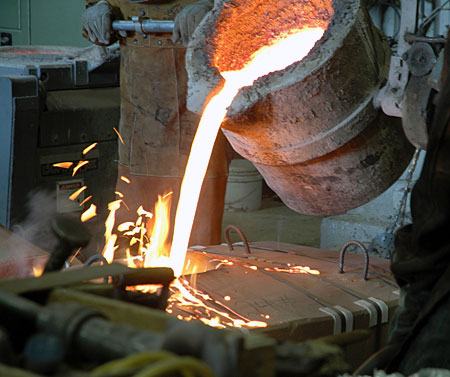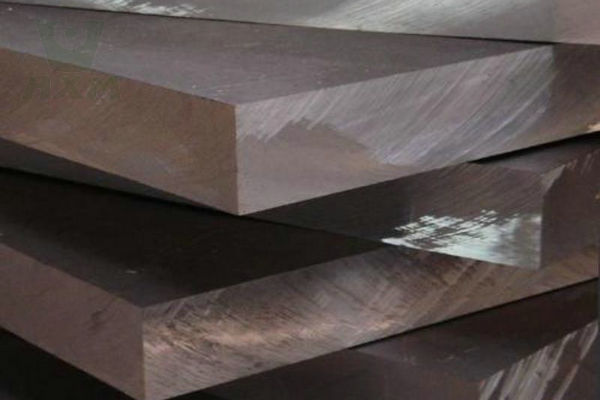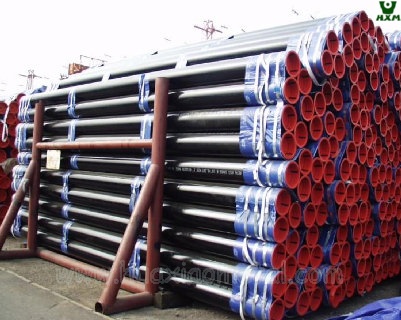Forged carbon steel is a combination of two basic metallurgical components, carbon steel, and forgings. Carbon steel is a broad term that applies to steels of all compositions, excluding stainless steel. Forging is a metal-forming process that uses repeated force to compress a heated billet of metal into the desired final shape.
Forging is often used to produce finished parts due to the lack of defects inherent in steel structures by other manufacturing methods, making parts well-suited for high-temperature and high-pressure applications. Some common forged carbon steel parts include machinery, valves, and piping system components. Hand forging is done by blacksmiths.

Carbon steel is a generic designator for a family of steel alloys primarily alloyed with carbon, along with varying amounts of other elements such as tungsten, cobalt, and chromium. Typically when defining carbon steels, no minimum or maximum concentrations are quoted for these elements, although stainless steels are generally accepted to be ineligible.
In other words, the concentration of primary carbon and secondary alloying elements can be adjusted to suit the intended end use of the steel. For example, increasing the carbon content in an alloy increases its hardness while reducing its ductility. Forging is one of the oldest methods of metal forming, which involves repeated human or powered shocks to force red-hot steel into a certain shape.
The metal is heated in a forge and then hammered in a forming jig or between the two halves of a complete device to achieve its final shape. Hand blacksmithing is performed by a smaller hand-held blacksmith with hammers, pliers, and chisels, and the hammering is usually performed on an anvil. Forged carbon steel produced by power forges is hammered with a large stroke hammer capable of exerting a great deal of pressure when striking hot metal in some cases.
Forged carbon steel parts are generally considered superior to parts made by other methods such as casting. , this is because the hammering of the metal during the forming process eliminates most microscopic crystallographic defects such as bubbles and cracks. This structural integrity makes forged carbon steel parts stronger and more suitable for applications involving high pressure and high temperature. This strength makes these forgings ideal for oil and gas piping systems, mechanical parts, and the internal mechanisms of high-pressure valves.
Forged Carbon steel to determine the initial forging temperature
Carbon steel forging should ensure that the bad material does not overburn during the heating process, and at the same time try to avoid overheating. Therefore, the initial forging temperature of carbon steel should be 150 ~ 250 lower than the solidus. The initial forging temperature of carbon steel decreases with the increase in carbon content.
Alloy steel tends to decrease more with the increase in carbon content. When determining the final forging temperature, it is necessary to ensure that the metal has sufficient plasticity before final forging, and it is also necessary to ensure that the forging can obtain good microstructure and properties.
Therefore, the final forging temperature should not be too high. If the temperature is too high, the grains of the forging will be coarse, and abnormal structures will appear when cooling after forging. On the contrary, if the temperature is too low, it will not only lead to work hardening in the later stage of forging, and may cause forging cracks, but also make the forging part in a critical deformation state, forming coarse grains.
Therefore, usually, the final forging temperature of steel should be slightly higher than its recrystallization temperature. According to the above principles, the final forging temperature of carbon steel is about 25 to 75 above the line. The final forging temperature of medium carbon steel is located in the austenite single-phase region, the structure is uniform, and the plasticity is good, which fully meets the requirements of final forging.
Although the final forging temperature of low-carbon steel is in the dual-phase region of austenite and ferrite, it will not bring difficulties to forging because of the good plasticity of the two phases. The final forging temperature of high-carbon steel is in the dual-phase region of austenite and cementite. When forging in this temperature range, the precipitated cementite can be broken into dispersion by means of plastic deformation. Final forging at a certain temperature will cause reticular cementite to precipitate along the grain boundaries after forging.







